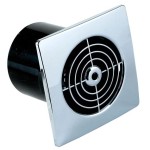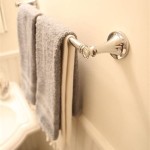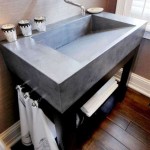The Open Grid Bathroom Sink Drain With Overflow: Understanding Functionality and Installation
The open grid bathroom sink drain, particularly those equipped with an overflow feature, represents a common yet crucial component of bathroom plumbing. Its primary function is to efficiently remove wastewater from the sink while preventing overflow when the water level rises excessively. This article will delve into the mechanics, advantages, installation procedures, maintenance routines, and potential issues associated with open grid drains that incorporate an overflow mechanism. Understanding these aspects is essential for homeowners, plumbers, and construction professionals alike.
Open grid drains are characterized by a grate, often constructed from metal, positioned directly above the drainpipe. This grate allows water to flow freely while simultaneously preventing larger debris from entering the plumbing system. The 'open' designation refers to the direct, unobstructed path the water takes into the drain, contrasting with pop-up or stopper-based drain designs. The addition of an overflow is a safety measure, preventing water from spilling onto the bathroom floor if the drain is blocked or the faucet is left running unintentionally.
Key Point 1: Functional Design and Mechanics
The core function of the open grid drain is simple: to provide a clear and unimpeded channel for water to exit the sink bowl. The grid itself acts as a filter, catching hair, soap scum, and other particulate matter that could potentially clog the drainpipe further downstream. The design minimizes the possibility of these materials accumulating directly within the drain body, contributing to a more efficient drainage process.
The overflow mechanism, integral to many open grid drain designs, consists of an opening or series of openings located near the upper rim of the sink basin. These openings connect to a channel that leads down to the main drainpipe, usually via a section of tubing or piping. When the water level in the sink reaches the overflow opening, the excess water flows into this channel and is directed down the drain, preventing the sink from overfilling. The overflow design relies on gravity and pressure differences to effectively divert the excess water.
The connection point where the overflow channel meets the main drainpipe is particularly important. It must be properly sealed to prevent leaks and potential water damage. The type of sealant or hardware used in this connection should be compatible with the materials of both the overflow channel and the drainpipe to ensure a lasting, watertight bond. Failure to properly seal this area is a common source of leaks in bathroom sinks with overflow drains.
The open grid design also offers a visual cue that the drain is functioning correctly. If water is pooling in the sink, even with the faucet turned off, it indicates a potential blockage downstream in the drainpipe. Similarly, a gurgling sound emanating from the drain often signifies a partial blockage or an air pocket in the plumbing system. These auditory and visual indicators allow for early detection and rectification of minor plumbing issues before they escalate into major problems.
Key Point 2: Installation Procedures and Considerations
Installing an open grid bathroom sink drain with overflow requires careful attention to detail and adherence to proper plumbing practices. The process typically involves several steps, beginning with the removal of the old drain assembly, if one is present. This may require loosening nuts and bolts, disconnecting the drainpipe, and carefully extracting the old drain body from the sink basin.
Before installing the new drain, it is crucial to thoroughly clean the sink basin and the surrounding area. Removing any old sealant, debris, or mineral buildup ensures a clean surface for the new drain to seat against. Failure to do so can compromise the seal between the drain and the sink, leading to leaks.
The installation of the new drain typically involves applying a plumber's putty or silicone sealant to the underside of the drain flange, which is the portion that sits against the sink basin. The drain body is then inserted through the drain opening from above, and the mounting hardware is attached from below. This hardware usually consists of a rubber or plastic washer, a cardboard washer, and a metal nut.
Tightening the nut securely compresses the washers and the plumber's putty, creating a watertight seal. It is important to avoid overtightening the nut, as this can crack the sink basin, particularly if it is made of porcelain or ceramic. A moderate, consistent tightening ensures a secure and leak-free connection. After tightening the nut, excess plumber's putty should be removed from the perimeter of the drain flange for a clean aesthetic.
Connecting the overflow tube is the next critical step. The overflow tube connects the overflow opening in the sink basin to a corresponding opening in the drainpipe. This connection must also be watertight to prevent leaks. Often, this connection involves a rubber or plastic gasket that is compressed by a nut or clamp. Ensuring the gasket is properly seated and the nut or clamp is tightened sufficiently is essential for a leak-free overflow system.
Finally, the drainpipe must be connected to the drain body. This connection typically involves a slip joint connection, which uses a nut and washer to compress a beveled edge against the drainpipe, creating a seal. The drainpipe should be aligned properly to ensure a smooth and unobstructed flow of water. After all connections are made, a leak test should be conducted by running water into the sink and observing for any leaks around the drain flange, the overflow tube connection, and the drainpipe connection. Any leaks should be addressed immediately by tightening the connections or reapplying sealant as needed.
Key Point 3: Maintenance and Troubleshooting
Maintaining an open grid bathroom sink drain with overflow is relatively straightforward but essential for preventing clogs and ensuring long-term functionality. Regular cleaning of the grid is recommended to remove accumulated hair, soap scum, and other debris. This can be accomplished by simply lifting the grid and wiping it clean with a cloth or brush.
Periodically flushing the overflow channel with hot water can also help prevent buildup and maintain its functionality. This can be done by filling the sink with water until it reaches the overflow opening and then allowing the water to drain through the overflow channel. This helps dislodge any accumulated debris and ensures the overflow is functioning properly.
Troubleshooting issues with an open grid drain often involves identifying the source of the problem. If the sink is draining slowly, the issue is likely a clog in the drainpipe downstream from the drain body. This can be addressed using a plunger, a drain snake, or a chemical drain cleaner. However, caution should be exercised when using chemical drain cleaners, as they can damage certain types of pipes and can be harmful to the environment.
If the sink is leaking around the drain flange, the issue is likely a compromised seal between the drain flange and the sink basin. This may require removing the drain, reapplying plumber's putty or silicone sealant, and reinstalling the drain. It is important to ensure the surface of the sink basin is clean and dry before reapplying sealant.
If the sink is leaking around the overflow tube connection, the issue is likely a worn or damaged gasket. This may require replacing the gasket and ensuring the connection is properly tightened. It is important to use a gasket that is compatible with the materials of the overflow tube and the drainpipe.
Another common issue is a foul odor emanating from the drain. This is often caused by bacteria and organic matter accumulating in the drainpipe or the overflow channel. Flushing the drain with a mixture of baking soda and vinegar can help neutralize the odor and kill bacteria. Alternatively, a commercial drain cleaner can be used, but again, caution should be exercised.
In cases of persistent clogging or leaking, it may be necessary to consult a professional plumber. A plumber can diagnose the problem accurately and provide the appropriate solution, whether it involves clearing a deep-seated clog, repairing damaged pipes, or replacing the drain assembly altogether. Regular maintenance and prompt attention to minor issues can help prevent more serious plumbing problems and extend the lifespan of the open grid bathroom sink drain with overflow.
The material composition of the drain also plays a role in longevity and maintenance. Brass and stainless steel drains are generally more durable and resistant to corrosion than plastic drains. However, plastic drains are often less expensive and easier to install. The choice of material depends on individual preferences, budget constraints, and the specific requirements of the plumbing system.

Keeney Trudrain 1 4 In Open Grid Bathroom Sink Drain With Overflow Polished Chrome 5680ctk The Home Depot

Keeney Trudrain 1 4 In Open Grid Bathroom Sink Drain With Overflow Polished Chrome 5680ctk The Home Depot

Keeney Trudrain 1 4 In Open Grid Bathroom Sink Drain With Overflow Polished Chrome 5680ctk The Home Depot

Lavatory Grid Drain With Overflow Barclay S Limited

Chrome Black Gold Open Grid Bathroom Pop Up Sink Drain Stopper Without Overflow

Keeney Trudrain 1 4 In Open Grid Bathroom Sink Drain With Overflow Polished Chrome 5680ctk The Home Depot

Keeney Trudrain 1 4 In Open Grid Bathroom Sink Drain With Overflow Polished Chrome 5680ctk The Home Depot

Keeney Trudrain 1 4 In Open Grid Bathroom Sink Drain With Overflow Polished Chrome 5680ctk The Home Depot

33t260 Delta 1 4 X 8 Open Grid Strainer Bathroom Sink Drain With Overflow Holes Chrome Amre Supply

Keeney Brushed Nickel Bathroom Decorative Sink Drain In The Drains Stoppers Department At Com
Related Posts







